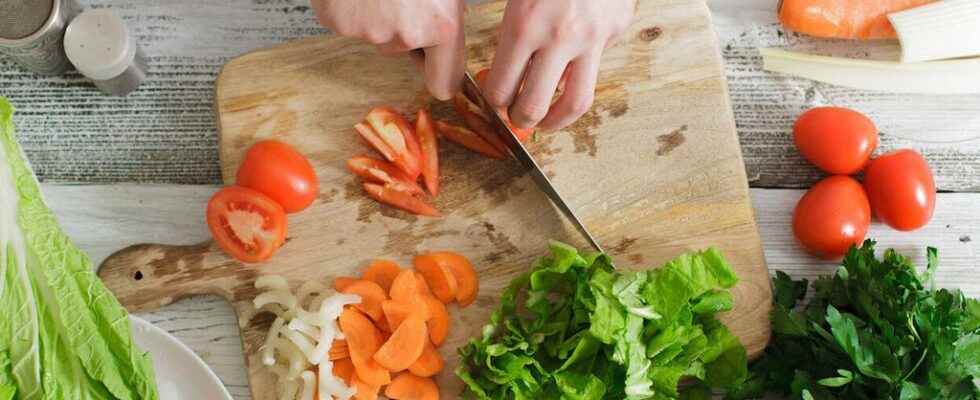Eating raw or cooked fruits and vegetables is not just a matter of taste. The nutritional profile of the same food varies according to its method of preparation. Vitamin content, digestibility, the dietitian-nutritionist Raphaël Gruman tells you all about the advantages and disadvantages of the two modes of consumption.
We take advantage of vitamin C
Vitamin, are you there? On the micronutrient side, one of the main differences between a cooked or raw vegetable or fruit is its vitamin C content (immunity support, anti fatigue, antioxidant …). “It is very sensitive to cooking, points out Raphaël Gruman, dietitian-nutritionist. This is not the case with other vitamins, such as beta-carotene for example.” For a fruit or vegetable to be at the top of its vitamin C content, it is not enough to eat it raw. It must also be extra fresh (no long stay in the refrigerator, before or after purchase) and tasted very quickly after being prepared (grated, peeled, pressed …). Finally, not all raw fruits and vegetables are champions of vitamin C either, although they have other strengths.
We digest the fibers
Eaten raw, fruits and vegetables have a higher content of insoluble fiber. These act in concert with soluble fiber to support intestinal transit. Flat stomachs to us? Not necessarily. Because raw vegetables can be poorly tolerated in cases of intestinal sensitivity or irritable bowel, and cause abdominal cramps, bloating, or even diarrhea. Cooking can then be of real interest. “It acts on insoluble fibers by softening them, which makes them easier to digest”, specifies our expert. However, it remains possible to adapt its sensitivity (non-pathological) to insoluble fibers, by very gradually increasing the quantity of raw vegetables on the plate and at the same time promoting the consumption of probiotic foods (yogurt, etc.). These allow to rebalance the intestinal flora in order to hope in the long term for a better digestion of the fibers.
Tomatoes: raw or cooked?
Raw tomato is more hydrating than the cooked tomato, of which much of the water evaporates during its cooking. In equal portions, it is therefore less caloric. Raw, the tomato also contains some vitamin C.
The cooked tomato contains lycopene, an antioxidant molecule potentiated by heat: cooking makes it bio available, that is to say assimilable by the body. This carotenoid helps fight against free radicals, responsible for cell aging and is also involved in the prevention of certain cancers (particularly female). The skin of the tomato can be indigestible, it is preferable to remove it before cooking (after having scalded and then cooled the tomato).
>> Discover 15 recipes with tomatoes
Peppers: raw or cooked?
Crus: unlike green peppers, red and yellow peppers are very high in vitamin C, a heat sensitive vitamin. If you want to take advantage of them, it is better to consume them raw.
Cooked : it is possible to gain digestibility by roasting peppers in the oven to remove their skin and soften their fibers. The peppers will be less rich in vitamin C than eaten raw, but will retain their beta-carotene content, a vitamin that is interesting for our skin “
>> Discover 9 recipes with peppers
Carrots: raw or cooked?
Floods : for vegetables rich in carbohydrates – such as carrots or beets – the notion of glycemic index must be taken into account. It is lower when we consume these raw foods. Consumed raw, the carrot also has a higher power of satiety.
Cooked: the soluble fibers in cooked carrots are sweeter. They have a capacity to absorb water which is useful in the event of an episode of diarrhea (gastroenteritis, turista).
>> Discover 15 carrot recipes
Stone fruits: raw or cooked?
Vintage : to take advantage of their water content, peaches, apricots or even plums are eaten raw. They are eaten as they are or cut into quarters, with a hint of cinnamon, in yogurt or on white cheese.
Cooked: cooking destroys the vitamin C contained in these fruits, but it also partially breaks down the fibers, which allows better digestion when one is sensitive or prone to bloating.
>> Discover 12 recipes with plums and mirabelle plums
The berries: raw or cooked?
Floods: blueberries, redcurrant, blackcurrant, raspberries, have a good content of vitamin C, antioxidant. It is interesting to consume them raw, to benefit from them. They are eaten as they are or lightly crushed, on Greek or soy yoghurt, or with fresh goat cheese.
Cooked : cooking reduces the acidity rate of these fruits. It is an interesting option if one suffers from a sour stomach. The antioxidant power of anthocyanins (pigments contained in the skin of blackcurrants and blueberries in particular) is not affected by cooking.
>> Discover 9 antioxidant recipes with blueberries
Green beans and eggplants: never eat them raw
“In the raw state, beans and eggplants contain a molecule toxic to the liver, warns our expert. Cooking inactivates it and thus makes these vegetables edible.” The more the beans are cooked, the more their fibers are softened and digestible … but lose in taste interest. Sliced and cooked “al dente”: a good compromise. Eggplant will be easier to digest without its skin. The latter nevertheless contains antioxidant pigments, which it would be a shame to do without. Adapt its preparation to your intestinal sensitivity.
Our expert: Raphaël Gruman, dietitian-nutritionist.
Subscribe to the Top Santé Newsletter to receive the latest news for free








